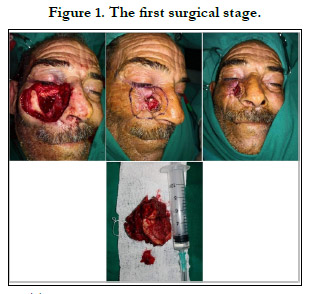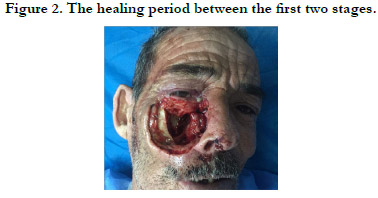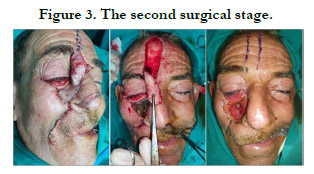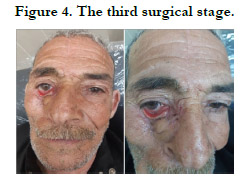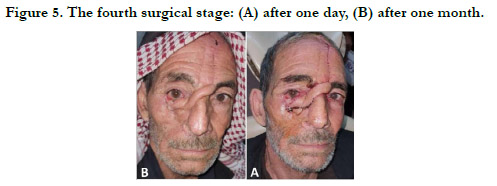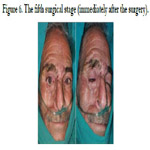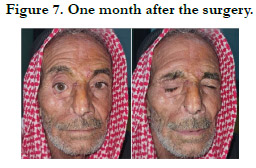Management Of Multi Stages Case Of Basal Cell Carcinoma By Hand Of Oral And Maxillofacial Surgeon
Ali Al-awad1*, Ammar Al Mofti2, Amam Ali Amam3, Sami Ibrahim4
1 Department of Oral and Maxillofacial Surgery, General Assembly of Damascus Hospital, Damascus, Syria.
2 Department of Oral and Maxillofacial Surgery and oncology, Damascus University, Damascus, Syria.
3 Department of Periodontics and Implantology, Damascus University, Damascus, Syria.
4 Department of Oral and Maxillofacial Surgery, General Assembly of Damascus Hospital, Damascus, Syria.
*Corresponding Author
Ali Al-awad,
Department of Oral and Maxillofacial Surgery, General Assembly of Damascus Hospital, Damascus, Syria.
Tel: +963935202048
E-mail: ali.alawad91@hotmail.com
Received: September 19, 2021; Accepted: November 17, 2021; Published: November 20, 2021
Citation: Ali Al-awad, Ammar Al Mofti, Amam Ali Amam, Sami Ibrahim. Management Of Multi Stages Case Of Basal Cell Carcinoma By Hand Of Oral And Maxillofacial
Surgeon. Int J Dentistry Oral Sci. 2021;8(11):5061-5063. doi: dx.doi.org/10.19070/2377-8075-210001019
Copyright: Ali Al-awad©2021. This is an open-access article distributed under the terms of the Creative Commons Attribution License, which permits unrestricted use, distribution and reproduction in any medium, provided the original author and source are credited.
Abstract
Basal cell carcinoma (BCC) is the most common skin cancer in the Caucasian population. This cancer arises in sun exposed
area of skin.
The incidence of morbidity is high and it is still growing and the metastatic rate is low but the enlarging tumor may cause
severe tissue disfigurement and poor cosmetic outcome.
The main problem in basal cell carcinoma management is the high recurrence rate.
2.Introduction
3.Materials and Methods
3.Results
4.Discussion
5.Conclusion
5.References
Keywords
Basal Cell Carcinoma; Eyelid Reconstruction; Forehead Flap; Skin Malignancies.
Introduction
Basal cell carcinoma (BCC) is one of the wide spectrums of neoplastic
disorders that can emerge in the head and neck region [1,
2].
Greater proportion of face cancers is diagnosed and referred for
treatment by maxillofacial surgeons [3]. Today an increasing number
of oral and maxillofacial surgeons are additionally trained in
the treatment of head and neck malignancies [4].
Surgery remains the primary treatment modality for head and
neck cancers. Face cancers poses a signification challenge to
OMFS specialty [5]. As the future unfolds advanced in molecular
biology, cell signaling immunomodulation and angiogenesis will
result is novel targeted therapies that will allow patients with cancer
to live longer and healthier lives [5, 6].
Herein, we present un important case of BCC in azygomatic area.
Case Report
A 72-year-old man consulted the department of oral and maxillofacial
surgery because of “there is an ulcer increasing in size in
the region between nose border and right eye”.
History of Present Illness
The patient complained of 6-months history of progressive nonpainful
ulcer of his skin distal nose and lower his right eye. The
patient denied any history of pain, fever or purulence, he reports
neurosensory changes in this area in the last month.
Clinical Examination
The patient has obvious ulcer in the referred area,the ulcer was
soft in center and had hard borders, non-tender to palpation. eye
movements were not affected. There were no facial or trigeminal
nerve deficits except neurosensory changes in the ulcer area.Neck:
there were no palpable mass and no cervical lymphadenopathy.
Incisional biopsy of the lesion was done for histopathology examination.
The biopsy report case of nodular basal cell carcinoma with multiple mitosis surrounded by dense stroma.
Radiographic examination
A computed tomography (CT) scan of the head and neck is the
commonly used imaging study of choice to delineated the lesion
and assess the neck for cervical lymphadenopathy. In the current
patient axial and coronal CT images of the head and neck revealed
well-circumscribed lesion of the right lateral border of the
nose and right zygoma. no evidence of cervical lymphadenopathy
was noted.
Surgical procedure
The surgical procedures were done over five stages in different
times.
The first stage: after the oral and endotracheal intubation, the border
of incision was marked taking into consideration the margins
of safety involving part of skin and cartilage of nose, skin of
zygomatic area and underlying bone and part of lower eyelid, in
this stage the whole mass of tumor was removed and sterilized
dressing packed in the area. (Figure 1, 2)
The second stage: after oral and endotracheal intubation, we
closed the entire defect by both right axial forehead flap and localized
random flap from the cheek (this stage was done after 2
months of cancer removal). (Figure 3)
The third stage: under local anesthesia,the forehead flap was separated
after about 20 days. (Figure 4)
The fourth stage: after oral and endotracheal intubation, left forehead
axial flap was used for reconstruction of the lower eyelid.
(Figure 5)
The final stage:after 1 month and under local anesthesia, the left
forehead flap was separated and new lower eyelid in its place, we
checked the eye movement (open and close) in the normal range
with normal appearance.(Figure 6, 7)
Discussion
Basal cell carcinoma starts as small shiny bumps usually on nose
or other parts of face, but can occur on any part of body including
trunk, legs and arms [1, 2, 5].
BCC usually grows very slowly and often doesn’t show up for
many years after in ten or long-term exposure to the sun [7, 8].
Diagnosis is usually clinical and clinical features are dependent on
the subtype of BCC [4, 9].
Skin biopsy is usually taken to identify a histological subtype of
BCC for treatment planning. BCC may it be part of gorlin syndrome
so, the diagnosis should be accurate [10, 11].
Conclusion
The available data suggest that surgical methods remain the gold
standard in BCC treatment. And the surgeon must has the ability
to deal with complex cases anatomically, surgically and cosmetically.
References
-
[1]. Kim DP, Kus KJB, Ruiz E. Basal Cell Carcinoma Review. Hematol Oncol
Clin North Am. 2019 Feb;33(1):13-24. PubMed PMID: 30497670.
[2]. Marzuka AG, Book SE. Basal cell carcinoma: pathogenesis, epidemiology, clinical features, diagnosis, histopathology, and management. Yale J Biol Med. 2015 Jun 1;88(2):167-79. PubMed PMID: 26029015.
[3]. Clark CM, Furniss M, Mackay-Wiggan JM. Basal cell carcinoma: an evidence- based treatment update. Am J Clin Dermatol. 2014 Jul;15(3):197- 216. PubMed PMID: 24733429.
[4]. Tanese K. Diagnosis and Management of Basal Cell Carcinoma. Curr Treat Options Oncol. 2019 Feb 11;20(2):13. PubMed PMID: 30741348.
[5]. Schmitz L, Dirschka T. Therapie des Basalzellkarzinoms [Therapy of basal cell carcinoma]. Hautarzt. 2016 Jun;67(6):483-99. German. PubMed PMID: 27206448.
[6]. Berking C, Hauschild A, Kölbl O, Mast G, Gutzmer R. Basal cell carcinoma- treatments for the commonest skin cancer. Dtsch Arztebl Int. 2014 May 30;111(22):389-95. PubMed PMID: 24980564.
[7]. Wiznia LE, Federman DG. Treatment of Basal Cell Carcinoma in the Elderly: What Nondermatologists Need to Know. Am J Med. 2016 Jul;129(7):655- 60. PubMed PMID: 27046242.
[8]. Basset-Seguin N, Herms F. Update in the Management of Basal Cell Carcinoma. Acta Derm Venereol. 2020 Jun 3;100(11):adv00140. PubMed PMID: 32346750.
[9]. Mendez BM, Thornton JF. Current Basal and Squamous Cell Skin Cancer Management. Plast Reconstr Surg. 2018 Sep;142(3):373e-387e. PubMed PMID: 30148788.
[10]. Glud M, Omland SH, Gniadecki R. [Basal cell carcinoma surgery]. Ugeskr Laeger. 2016 May 16;178(20):V07150603. Danish. PubMed PMID: 27189106.
[11]. Di Stefani A, Chimenti S. Basal cell carcinoma: clinical and pathological features. G Ital Dermatol Venereol. 2015 Aug;150(4):385-91. PubMed PMID: 26099353.

